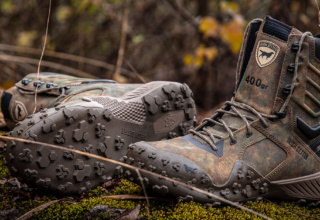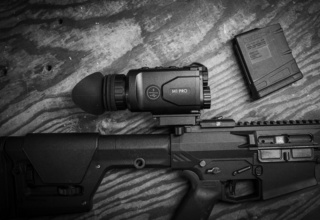 For some predator hunters, having to take a shot at a coyote that is at a long distance is a last resort. To the other half, there is an unexplainable thrill that comes from having the shooting skills to pull off the harvest, no matter how far the target. Regardless of which category the hunter falls into, there are ways to become a more successful long-range predator hunter.
For some predator hunters, having to take a shot at a coyote that is at a long distance is a last resort. To the other half, there is an unexplainable thrill that comes from having the shooting skills to pull off the harvest, no matter how far the target. Regardless of which category the hunter falls into, there are ways to become a more successful long-range predator hunter.
For years I wasn’t the biggest fan of taking a shot at a coyote that was over 200 yards. This was due to the fact that I wasn’t confident that I could pull off that long of a shot and not being comfortable with my equipment was the main factor of my fear. However, once I started putting more thought into how my firearm performed, combined with the simple task of shooting more, I began to overcome my fear which in turn made me a more successful hunter.
Choosing the Right Firearm
 The only way to become more comfortable with firearms is to first choose the right ones that are capable of doing the job. There are several calibers of firearms that are more than capable of making a shot on a coyote all the way to 400 yards. Some of those calibers include a .223, .22-250, .243, 6.5 Creedmoor, and a .308, to name a few.
The only way to become more comfortable with firearms is to first choose the right ones that are capable of doing the job. There are several calibers of firearms that are more than capable of making a shot on a coyote all the way to 400 yards. Some of those calibers include a .223, .22-250, .243, 6.5 Creedmoor, and a .308, to name a few.
Although many hunters are fond of a quality bolt action rifle to reach out to further distances, I have found that an AR style rifle is the better choice. Choosing a quality AR such as the Rock River Arms LAR-8 allows the hunter to have a firearm that is accurate, as well as the option of being able to make multiple follow up shots. Hunting open areas is ideal due to increasing the time a spotted coyote can be tracked. This allows for more preparation time before making the shot and if a coyote comes in and then suddenly leaves, there is still time for multiple shots. Don’t be afraid to shoot at a coyote when it is running away, many hunters are successful in leading the shot to be able to harvest a coyote that would have normally been long gone. Check out this great video by Fred Eichler on shooting running coyotes.
Practice on The Range
Knowing how the rifle performs is more important when shooting predators over any other type of hunting. The majority of the 3 main predators that are hunted (coyote, fox and bobcat) have bodies that are fairly small. Even with a coyote, if it is at 100 yards and facing the hunter, the kill zone is narrowed down to approximately a 5” circle. Take that same animal out to 300-500 yards, even when broadside the chance of error is compounded.
Being a good shot is crucial in being successful and therefore it is important to spend some time at home or at the gun range shooting. A hunter needs to know what ammunition shoots the best out of their particular firearm, they also need to know at what distance the bullet begins to fall. This will help to determine where to aim in a real hunting situation. The only way to achieve this is by spending time behind the trigger learning first-hand while shooting. Knowing your firearms capabilities in every situation will make for a more confident shooter, which makes for a more successful hunter.
Must Haves When Hunting
 There are two things that a long-range predator hunter must have to be ready for the shot. The first thing is a solid rest. When shooting at longer distances the slightest movement can make or break the shot. There are many rests on the market that are designed specifically for hunting. My personal preference is Swagger Bipods – which are a self-storing, retractable leg style bipod. They allow for the bipod to be attached to the gun which means one less thing to carry, plus they have flexible legs which allows for hunting any terrain. This includes standing, sitting, or laying on the ground. Find a rest that fits your needs, then practice with it before hunting.
There are two things that a long-range predator hunter must have to be ready for the shot. The first thing is a solid rest. When shooting at longer distances the slightest movement can make or break the shot. There are many rests on the market that are designed specifically for hunting. My personal preference is Swagger Bipods – which are a self-storing, retractable leg style bipod. They allow for the bipod to be attached to the gun which means one less thing to carry, plus they have flexible legs which allows for hunting any terrain. This includes standing, sitting, or laying on the ground. Find a rest that fits your needs, then practice with it before hunting.
The second thing needed is a quality range finder. The first thing that I do after I sit down to call predators is to use my range finder to mark several different landmarks, so that when a predator is approaching I will know exactly how far he is and where I need to be aiming. I recently started using the new Nikon Monarch 3000 Stabilized Laser Rangefinder. It is exceptionally designed for the long-range hunter. When using a small rangefinder to detect a small object such as a coyote at 300 to 500 yards it can be challenging to hold steady enough to get a true reading, this rangefinder has built in stabilization to get an accurate reading at extreme long distances.
During a hunt last fall, a friend and I were headed to our 3rd stand of the morning. By this time it was mid-morning and the sun was beginning to fill the side of steep hill where we headed to make our next set up. When we arrived at a cattle gate that entered into the pasture we quickly discovered that there was already a coyote mousing at the far end the field. As my hunting partner braced himself against a large wooden corner post, he assured me that he had a steady enough rest that he could make the shot. I took my rangefinder and gave him a reading of 317 yards. Once he was ready I watched to see where he hit. The first shot connected perfectly as the coyote ran 15 yards before tipping over in a nearby brush pile. This hunt is a testimony that if you know how your trusty firearm shoots, have a steady rest and know the distance with a rangefinder; longer shots can be made with no hesitation.

















